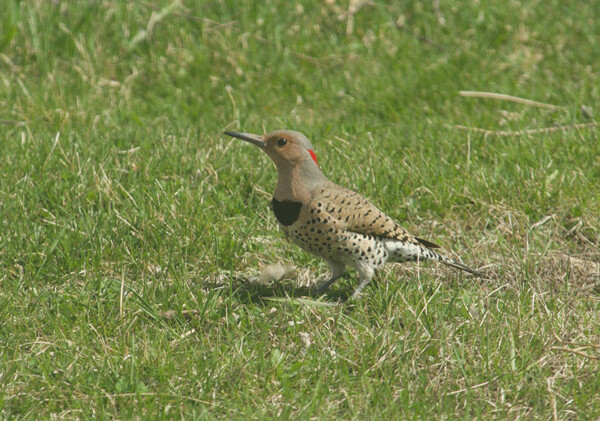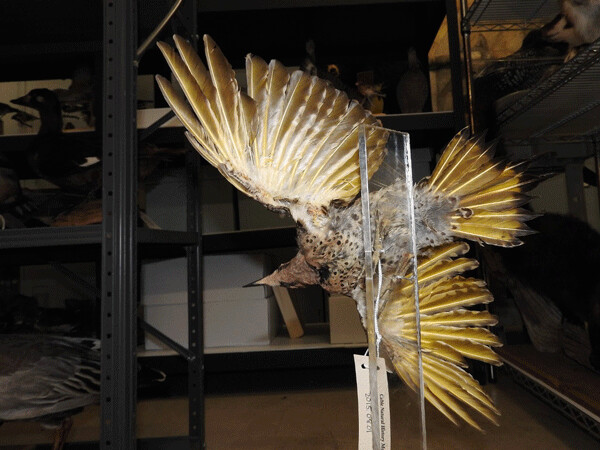News & Articles
Browse all content by date.

Glimpses of sunshine were hard to find over the past few days. So low and heavy were the damp, gray clouds that I worried they might crush my soul. We’ve had a few nice days, though, and a week ago I was biking 30-40 miles per day on dryer, warmer roads. On those days, despite gray clouds, flickers of sunshine abounded.
Or rather, flickers themselves abounded. Northern flickers are one of our few migratory woodpeckers (sapsuckers are another), and as flocks of them swirl north on the leading edge of spring, they bring flashes of color to the landscape. You have to wait for it, though. Their backs are muted tan with black checks that blend in perfectly with the dried grass now carpeting road ditches. I almost never see one on the ground. It’s a delightful surprise, then, when they suddenly flush ahead of your car or bike and swoop into the woods with flashing bursts of gold. The yellow feathers on the undersides of their wings are secret bits of sunshine.
Why are these woodpeckers on the ground, anyway? That’s not where we spot downies, hairies, pileateds, and our other woodpeckers. In a little twist of habit, flickers use their long, pointed bills and their even longer barbed tongues to probe the ground and lap up ants. They also munch on beetles, flies, butterflies, moths, caterpillars, snails, and fruit.


As I zoom past on my bike, the flickers often give a squeaky “skew” as they startle, and then shout their kikikiki alarm calls from back in the trees. These sounds are also used as part of their mating ritual and to defend the area surrounding their nest. That’s enough of a responsibility to make their calls a significant part of the symphony of spring, but they’ve also learned to choose their battles.
Unlike many other animals, flickers don’t defend an extensive feeding territory from their neighbors. In 2003, a couple of scientists from Saskatchewan worked out the “calculations” behind this behavior. It all comes back to the ants.
Some ants live in huge anthills full of thousands of individuals. You’d think that would be a valuable bonanza for a pair of flickers to claim for their own. Unfortunately, the types of ants who live in huge colonies are also the most aggressive species, and according to the researchers, they are “unpalatable prey.” If you’ve ever disturbed one of those big anthills and been bitten, you might agree. Now imaging putting your face down in there!
The more docile ants who make up 45% of flickers’ diets live in smaller, ephemeral anthills. These anthills are easily washed away by rainstorms. After a short rainstorm, the ants are back to rebuilding within just a couple of hours. During several days of rain, though, they avoid coming to the surface. Even when it’s not raining, the ants are sensitive to high temperatures because their tiny bodies dry out quickly. So, in both rain and heat, they remain out of view underground.
The upshot of all this ant behavior is that flickers need to be able to forage throughout a wide home range—up to 1 mile in diameter—to make up for the unpredictable nature of their favorite food. Defending a feeding territory might result in them not having access to enough resources when the weather turns foul. In addition, small anthills are easily overharvested. So, several pairs of flickers may end up feeding in the same area based on the weather and consequent availability of ants.
With the cool, rainy weather and soggy ground, flickers probably can’t feed on ants right now anyway. Luckily they can be flexible. Rainy day foods include insect larvae, caterpillars, ant colonies under rocks, and the many things that crawl around in cow pies.
So, the flickers are probably just as eager to have some dry weather as I am. While we wait, they are generous enough to share their beautiful colors and raise my spirits with their flickering bits of sunshine.
Emily’s second book, Natural Connections: Dreaming of an Elfin Skimmer, is now available to purchase at www.cablemuseum.org/books and will soon be available at your local independent bookstore, too.
For 50 years, the Cable Natural History Museum has served to connect you to the Northwoods. Come visit us in Cable, WI! Our new Curiosity Center kids’ exhibit will open May 4. Grand Opening on May 25!
| Tweet |


